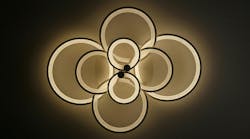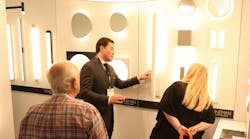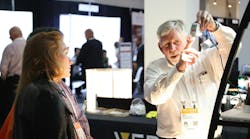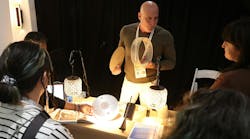MHT Lighting, the lighting fixtures business of MHT Technologies Inc., has returned all manufacturing operations to its U.S. facility, allowing the PoE hardware and software maker to reduce delivery times and circumvent supply-chain interruptions.
Company leaders point to changing market dynamics — increased U.S. tax incentives thanks to the Inflation Reduction Act as well as rising tariffs and import duties — as drivers for reshoring.
During its 15-year history, MHT Technologies evolved from building LED light fixtures to manufacturing components for those fixtures, all controlled via power-over-Ethernet (PoE) technology. When founded, the company operated solely from its facility in Staten Island, but over time, production transitioned to international fabricators in response to pricing pressures. Supply-chain interruptions that extended delivery times, among other effects, prompted CEO Akram "AK" Khalis to invest in new equipment and assembly lines, and add four team members, to reshore production, he said.
“The U.S. is poised to become an accelerator of intelligent buildings, which will push forward all kinds of worthy aspirations, from sustainability to workplace inclusion,” Khalis said in a release. “The more in control we are of our destiny through strategies like onshore production, the faster that vision can become a reality.”
In an interview with LightSPEC, Khalis shared his perspective on the evolving role of PoE technologies for architectural lighting and smart buildings. His answers have been edited.
You mention that shifting marketplace dynamics influenced the decision to reshore MHT’s lighting and controls manufacturing. Can you expand on those market forces and their effects?
Supply-chain reliability became a major focus for U.S. companies following the pandemic. Onshoring allows companies like MHT Technologies to create consistency — not only in quality, production and delivery, but also in cost.
It’s crucial for lighting firms that are innovating new products and solutions to deliver on their promises. In actuality, it’s crucial for the entire industry. Anytime a single IoT, AI or smart-devices firm lets their customers down, the halo effect decelerates progress toward some pretty exciting sustainability and occupant-experience outcomes. International supply chains increase the risk of disappointing customers, whether that’s due to production delays or in-field corrections.
Although the industry is making progress, it’s difficult enough to convince some building owners to consider even low voltage. You start throwing, for example, high-tech AI integrations in the mix, and you’re pushing an already heavy boulder up a steep hill. When any lighting or controls innovator gets to the top of that hill, the last thing you need is a bottlenecked ocean freighter rolling that boulder back down the hill — flattening you along its way.
Can you explain MHT’s role in the smart-building movement with its PoE-based hardware and software?
MHT’s Inspextor software is a lighting automation and controls technology that takes feedback from any number of sensors to either trigger or prescribe action. Said another way, Inspextor translates what the building is saying so humans can understand. The human can then collaborate with technology to either react to a circumstance or proactively plan to avoid a circumstance.
Given MHT’s lighting roots, most of Inspextor’s projects today are intended to drive lighting automation and controls. That said, Inspextor was engineered for the smart-building marketplace, which means it can connect to and analyze data from any number of IoT sensors, actuators and other devices to go far beyond lighting. Think HVAC, access, security/safety, occupancy monitoring and any number of other use cases.
Today, Inspextor is PoE-based. Power-over-Ethernet cables deliver both energy and data, saving building owners a lot on installation and maintenance costs. There are tremendous use cases for it, so we expect to see PoE projects double — if not triple — in volume in the very near term.
How widely is PoE being adopted in architectural lighting applications? Do you expect that trend to increase or decrease?
PoE as a technology has been proven for many years. Iterations of PoE will have a smaller footprint, which will allow it to be embedded inside a light fixture, for example. This will grant granular control in architectural lighting use cases. In these circumstances, you want to provide enough lumens without changing the aesthetic of the fixture. PoE achieves this seamlessly. The technology in essence “shrinks the driver” — or in many cases, multiple drivers — so it can fit into a light fixture that then becomes plug-and-play.
PoE lets building owners drive power and data to the same endpoint while also collecting data and information to create a more sustainable, productive and energy-efficient building. Especially as regulatory, political and societal pressures to reduce the carbon footprint of real estate amp up, PoE will stand out as an affordable, reliable option that checks a lot of the green boxes owners will be looking to check.
For owners not as concerned about the sustainable benefits, there are occupant-experience benefits that can create compelling differentiation. Commercial real estate is under a lot of competitive pressure to earn occupancy. PoE acts as a sort of “digital ceiling” that can flex and flow with the demands of the day. Last year, it was digital nomadism; today, it is office hoteling; tomorrow, it could be “bring your own android” policies.
Smart, connected human-centric lighting plays a role in many applications. How does PoE fit in?
Productivity, comfort, health and wellness are all things to consider when we think about human-centric lighting. Often, many can be ticked with the same strategy. Let’s take automating lighting for the human circadian rhythm as an example. PoE cannot only seamlessly enable bulbs to emulate the hour-by-hour changes in natural light; it can also connect those bulbs through an analytics dashboard that reports on its effectiveness for building owners. Plug in an occupancy sensor, for example, and see how many employees chose to work in a space illuminated for circadian rhythm. This is where you are seeing the direct benefits of having power and data delivered over the same cable.
Now, look at it from the sustainability lens. An office that is attempting to meet certain energy-reduction goals could integrate its daylight harvesting and lighting automation strategy. But to do so, building owners need to connect multiple technologies such as smart shades, automated HVAC and autonomous color, temperature and intensity settings for lights. Whether it’s Bluetooth, WiFi or a proprietary connection, PoE makes it all one technology stack.
How does MHT collaborate with lighting designers or specialists for smart-building projects?
We start by identifying the fixtures and their electrical specs — no different than in a traditional project. Knowing the circuitry and electrical characteristics allows us to provide the correct solution for that specific fixture or topology for the fixtures. From there, we move into the mechanical assembly and begin to think through the PoE controllers and PoE drivers. Where and how things will be mounted is a group effort between the designers, IT specialists and MHT’s team. We then lead testing and validating.
Are there any challenges with specifying PoE for architectural lighting?
Functionally, architectural lighting generally comes with power limitations. Ninety watts per port at 100 meters, for example — that’s a challenge for a PoE infrastructure.
More holistically, though, the challenge is one of awareness and education. When people learn what is possible, they get really excited. Imagine an AI light fixture that recognizes you — all on its own. It doesn’t have to scan your face, digitize the image, push it to a cloud server, analyze it, send it back and then take action. Powered by PoE and an edge-computing solution, the fixture sees you enter a space and instantaneously changes tone to your preference. Now imagine how that could help people with sensory sensitivities, patients in a hospital, or surgeons in an operating suite.
Too often people will just assume the characteristics of PoE are inflexible. That’s rarely the case. In fact, PoE is one of the most flexible assets a commercial property can possess in today’s fast-evolving environment.







